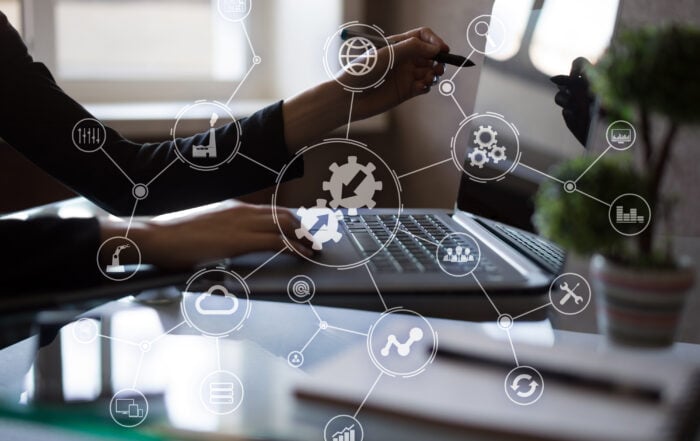QWERX Has Your Back: 3 Cybersecurity Trends To Watch Out For

Cybersecurity is as crucial to your business as deadbolts on your physical doors. The need for more advanced cybersecurity technology is clear and present as an effective method of combating the massive rise of cybercrimes and legislation. According to a study by Grand View Research:
- Worldwide, the demand for cybersecurity is estimated to reach over $500 billion by 2030, a compound annual growth rate (CAGR) of 12% from 2022 to 2030.
- Globally, securing cloud data had the highest revenue share at more than 25% in 2021.
- Intrusion detection systems (IDS) and intrusion prevention systems (IPS) market segments are expected to yield a CAGR of over 10% by 2030. This rapid growth is being bolstered by the ever-increasing demand for real-time threat detection across unknown networks.
“Cyber perils are the biggest concern for companies globally in 2022,” according to the Allianz Risk Barometer.
- 44% of respondents said cyber incidents posed the greatest risk to the business.
- 42% of respondents said business interruption was the primary fear.
- 25% of respondents said acts of Mother Nature and other weather disasters were of major concern.
These cybersecurity trends are only expected to grow from here. Smart companies will seek dynamic and robust cybersecurity solutions to these ubiquitous threats.
1. Bigger, Stronger, Faster, Smarter Attack Trends
Cyberattacks are increasingly widespread and becoming all the more sophisticated. As the digital world continues to replace or augment the analog bricks-and-mortar method of doing business, more and more cybercriminals are positioned to benefit from the digital shift. According to McKinsey & Company on the future outlook of the cybersecurity market:
- An estimated $101.5 billion is going to be spent on cybersecurity service providers, including consultants, hardware support, implementation and outsourcing.
- Cybercrime direct and indirect costs are expected to reach $10.5 trillion per year in 2025.
- Cyber insurance premiums are forecasted to have a CAGR of 21% through 2025.
Popular Cyberattack Trends
Cybersecurity threats are numerous and ever-changing. However, they affect all company sizes. Although the cyberattacks on megatech companies garner massive media attention, 1 in 5 cyber victims were small- and medium-sized businesses (SMBs) with an average loss/cost size of $21,659 according to the Verizon Data Breach Investigations Report.
Cyberattack-Packs
“Teamwork makes the dream work.” Cybercriminals are evolving. A lone wolf hacker is no longer the norm. Cyber-hacking is now an entire industry or even state-sponsored. Cyberattack-packs, or teams of hackers working on a common goal (to fleece you of your prized business data), are so large they can have organizational charts and R&D budgets. They use artificial intelligence, automation and machine learning pointed squarely at you. According to McKinsey & Co., advanced malware like Emotet can change its method of attack to speed up the aggression of its attack from what used to take weeks to days or hours, encompassing the malware cycle from reconnaissance to exploitation.
- QWERX Defense: Take your cyber game to the next level. Use cutting-edge and dynamic technologies and methods versus the outdated “fortress” model to defend your networks.
Ransomware
“Have I got a deal for you…” Paying a ransom to get what was already yours seems ridiculous, but ransomware is a growing cybersecurity trend for bad actors. Example: The Colonial Pipeline attack where a $5 million ransom was paid to regain control of their files and data. And in 2019, the city of Baltimore was forced to stop processing all incoming and outgoing payments when they were hit with ransomware.
- QWERX Defense: Take a no-nonsense evaluation of your most crucial company assets and likely points of failure. Complete a defensive checklist to fortify your system. Be proactive. Don’t wait for a catastrophe to take action.
Humans
Don’t forget user errors. Be it social engineering, pretexting, privilege abuse or stolen creds, your users represent a major gateway for cyberattacks. Social engineering is defined as compromising someone psychologically into breaching confidentiality or taking certain actions for cyberattacks. According to Verizon, 70% of social engineering and phishing incidents are only discovered by parties outside of the company. In other words, not only are users falling victim to cybersecurity fraud — they don’t even know they’re victims.
- QWERX Defense: Remove the user. Humans, intentionally or unintentionally, can pose a serious security risk. Removing the user altogether reduces the need for the popular (and ineffective) method of attempting to change human behavior with best practices they never asked for.
2. Cybersecurity Defensive Technology Trends
There isn’t a cure for all cybersecurity ailments. However, some methods are substantially better than others. Standard methods include network segmentation and copious and frequent backups. Consider these more dynamic and effective solutions:
Zero-Trust Architecture (ZTA)
“It’s not that I don’t trust you…” Instead of static defenses around physical networks, ZTA focuses on users, assets and resources. Enforcing policies are more precise, where even if users have access, they may not have access to sensitive data.
Homomorphic Encryption
“Today’s password is…” With the increase of overall computational capacity, this type of encryption allows users to work with encrypted data without decrypting it. This allows users and companies to access key data more securely and meet ever-tightening data privacy requirements.
Defensive ML and AI
Artificial intelligence and machine learning can play defense too. Your organization can deploy key AI and ML technologies to incorporate behavioral analytics of your users to address key vulnerabilities. For example, the analytics can search for anomalous user activity, whether intentional or unintentional and compare it to your established baseline behavior. Your empowered AI and ML can fortify your existing algorithms, making them more difficult to break.
3. Cybersecurity Legislation Trends
Organizations aren’t the only ones interested in cybersecurity trends. Federal and state government agencies are actively building a legislative cybersecurity architecture. According to the National Conference of State Legislatures:
- Over 250 bills or resolutions covering cybersecurity from at least 45 states and Puerto Rico have been introduced. Some key issues seeing the most interest include:
- Cybersecurity training and formal security protocols for government agencies.
- Cybersecurity insurance and regulating cybersecurity within the insurance industry.
- Creating task forces to study and advise on cybersecurity issues.
- In 2021, at least 36 states enacted bills covering cybersecurity, with roughly half of the states providing security measures to protect government resources.
The Securities and Exchange Commission (SEC) proposed new rules applicable to public companies. Previously, publicly traded companies were not required to disclose cybersecurity matters. An affected publicly traded company will be required to file a Form 8-K within four business days of any material cybersecurity incident. In 2022, certain financial companies including banks must report any “significant” cybersecurity incident within 36 hours of discovery.
Regardless of the size of your organization, the consensus is clear that cybersecurity is a regulatory trend with no signs of slowing down for the foreseeable future.
Staying Ahead of the Trends
Don’t go it alone. You need a dynamic cybersecurity defense team with a nonstandard solution set. QWERX can help you future-proof your security network with innovative technologies such as algorithm-free key generators based on chaos theory and replacing static with ephemeral credentials that expire before exploitation. Contact QWERX to take your cybersecurity defense to the next level.
Marty Aquino has been a passionate writer on venture capital, technology, forecasting, risk mitigation, wealth and entrepreneurial topics since 2009. He is the founder of Carbonwolf Energy, a venture-capital firm specializing in world-changing and status-quo-defying technologies and people.
Sources
Grand View Research - Cyber Security Market To Be Worth $500.70 Billion by 2030: Grand View Research, Inc.
McKinsey & Co - Cybersecurity Trends: Looking Over the Horizon
Verizon - 2021 Data Breach Investigations Report
The National Conference of State Legislatures (NCSL) - Cybersecurity Legislation 2021
Cyber Law Monitor - Federal Agencies Announce a New 36-Hour Cybersecurity Incident Rule Reporting Requirement
Cyber Law Monitor - SEC Proposes New Cybersecurity Disclosure Rules for Public Companies

